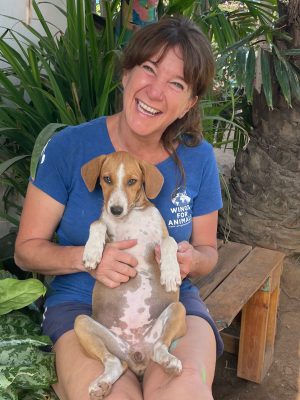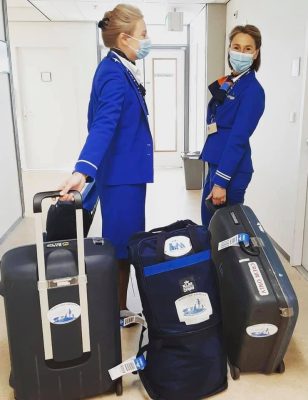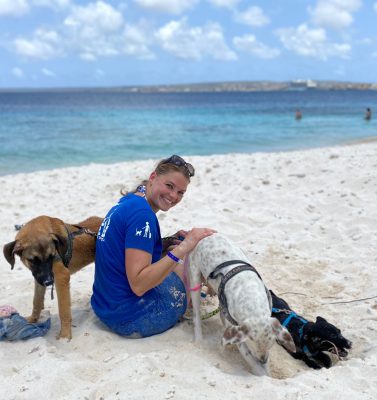Anyone who thinks flight attendants are just ‘beautiful dolls’ who do nothing but fly and lie on the beach is wrong. Annelies Moolenaar, a flight attendant for over 20 years, disproves this prejudice forcefully. Annelies started the Wings for Animals foundation in 2015. She collects items, supports local foundations and works very hard in the shelters that are located on their flight paths. Annelies has always been committed to the animals she encounters worldwide: “As an intercontinental flight attendant, you often stay at a location for at least 24 hours, so you have enough time to explore the area. In the first few years, I noticed how much stray animals and animal abuse there is in many places. In the beginning I tried to help strays by feeding them, but later I find out that is not the solution; you just make the problem worse. After all, by feeding the animals, you maintain the stray animal population, so you make the animals more resilient. It is better to take such an animal to a shelter where it can be sterilized and then put back again,” she explains. Once Annelies paid a visit to a shelter, she saw that the problem was much bigger than she thought. “Animal shelters are overcrowded and have too little money and capacity to help all the animals.” This made her desire to help animals worldwide even greater. “I wanted to make an impact and do something instead of just seeing everything happen.”
Wings for Animals
In 2015 Annelies thought it was time for action: “Through social media I discovered that I was not the only one who was very moved by all the suffering I witnessed. There were more colleagues who watched this and felt they should do something. I collected a list of names and approached them about the idea for a foundation. Everyone reacted positively and not much later I set up Wings for Animals together with four colleagues.” Annelies took the idea for Wings for Animals from her colleagues at Wings of Support. Annelies: “It’s a wonderful foundation, also consisting of crew members, committed to combating child poverty all over the world. I always thought it was very smart how they used their flight paths to provide aid worldwide. Flight attendants are allowed to take some extra baggage. This has resulted in a logistics solution for many foundations! We collect items that are useful for local foundations, such as food supplements, toys, anti-parasitics and other medical devices. But we can also help local projects when transporting materials. During the forest fires in Australia, for example, an initiative was started in Deventer to make gloves and pouches for injured koalas and kangaroos. We were able to transport these items on our routes. And there are many more local initiatives that we help.” The foundation now consists of three board members, three employees, three ambassadors and a number of regular donors. “The people behind the scenes who monitor the website and social media and make the annual report are indispensable, and my colleague board member Jacobien Vegter is also an indispensable link; she takes care of the storage of the items that are waiting for the right flight. And of course: the many volunteers who collect things for us, colleagues who transport things in their suitcases and the foundations we get the stuff from. For example, the DierenLot Foundation provides a large portion of the food and non-food.”
Goals
The foundation has set four goals: providing assistance, providing financial support, information and education and setting up sterilization projects. Annelies: “For all goals, we first visit a location before we get started. The first goal is self-evident; we go to shelters on our routes and lend a hand. This can be cleaning animal cages, walking or cuddling the animals or just delivering things. We provide financial support where possible; sometimes we start a fundraising for a specific purpose. The great thing about this way of working is that we can actually show donors what happens with their money. Because we visit the projects we support regularly, we also see for ourselves how the situation has improved and that gives us a lot of energy!”
Education
“Our education and information goal consists of teaching children. We take children from the area to an animal shelter and explain that animals do not deserve to live on the street and should be well cared for. But this goal also includes informing colleagues and tourists about animal abuse, such as elephant rides, swimming with dolphins and petting lion cubs. People need to be aware that this is not always a positive thing; very often they do not know how much animal suffering is caused by such tourist attractions.”
Sterilization projects
The last goal is a project in itself. Annelies explains: “Together with our three ambassadors, veterinarians Piet Hellemans and Jolande van den Broek, we set up sterilization projects in collaboration with local veterinarians. Of course a lot has to be arranged beforehand; we do this through consultation with each other and the foundations. We always visit the foundations on our routes, but we need more time for the sterilization projects. For this we book a trip on its own. The best thing is of course if the project is taken over by a local vet, so that the sterilization of animals can continue when we leave. Only in this way can the enormous stray animal problem be solved.” Wings for Animals has already started such projects in Thailand, Curaçao and Romania, among others. If it’s up to Annelies, the work is far from over: “Animals continue needing us worldwide.”
TCL all over the world, help us spreading our Wings to create a better future for animals and become our sponsor.
Want you to help reduce animal suffering around the world?
Visit www.wingsforanimals.org to discover what you can do.


